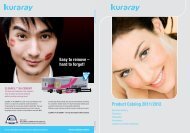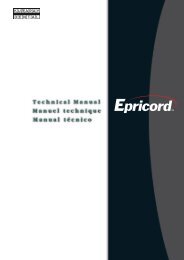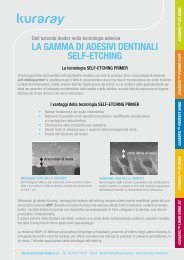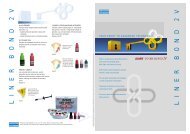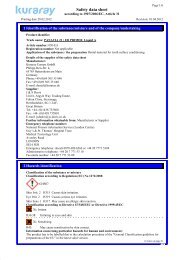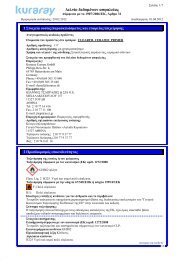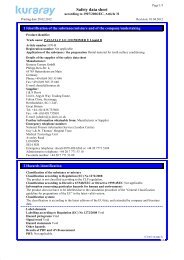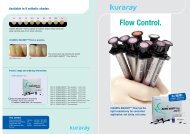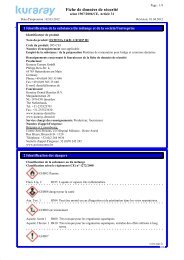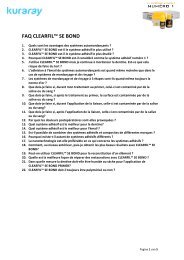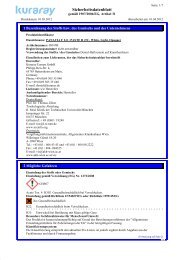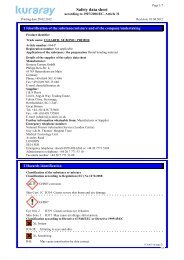PANAVIA™ F 2.0 Complete Kit Sales Folder
PANAVIA™ F 2.0 Complete Kit Sales Folder
PANAVIA™ F 2.0 Complete Kit Sales Folder
Create successful ePaper yourself
Turn your PDF publications into a flip-book with our unique Google optimized e-Paper software.
The excellent test results in detail.<br />
PANAVIA F <strong>2.0</strong> order information:<br />
Strong bond strength & consistent marginal integrity<br />
Kuraray's unique adhesive monomer MDP in<br />
the primer creates a strong chemical bond to<br />
hydroxylapatite. Being in use for more than<br />
20 years, the MDP has a proven excellence in<br />
Shear bond strength (MPa)<br />
Linear dye penetration<br />
30<br />
25<br />
20<br />
15<br />
10<br />
5<br />
0<br />
12,0<br />
10,0<br />
8,0<br />
6,0<br />
4,0<br />
2,0<br />
Groups:<br />
CH 3<br />
CH 23 =<br />
C<br />
C =<br />
O<br />
O<br />
CH2<br />
CH 2 CH 2<br />
CH 2 CH 2<br />
CH 2 CH 2<br />
CH 2 CH 2<br />
CH 2<br />
O<br />
O<br />
=<br />
P<br />
OH<br />
OH<br />
Structure of adhesive<br />
monomer MDP<br />
Shear bond strength to human tooth<br />
after 3.000 thermal-cycles<br />
PANAVIA F <strong>2.0</strong> RelyX Unicem Maxcem Elite Multilink Automix<br />
Leakage of different luting cements<br />
for quartz-fiber post cementation<br />
Harvard<br />
Cement<br />
Polymerizable group<br />
Hydrophobic group<br />
Hydrophilic group<br />
Forming the chemical bond with<br />
calcium and hydroxylapatite<br />
Ketac Cem<br />
Aplicap<br />
PANAVIA<br />
F <strong>2.0</strong><br />
RelyX<br />
Unicem<br />
Variolink<br />
ExciTE DSC<br />
PANAVIA F <strong>2.0</strong> in combination with ED PRIMER II revealed least leakage values when<br />
DTLight quartz fiber posts were inserted. (The boxplot diagram depicts the medium values<br />
and the 25 respectively 75 percentile values of the relevant measurements of cements.)<br />
adhesion. It is a guarantee for a high bond<br />
strength and shows a reliable adhesion<br />
durability to the tooth structures.<br />
Micro-tensile bond strength (MPa)<br />
Bond strength of resin cements to silica-based ceramic<br />
100<br />
80<br />
60<br />
40<br />
20<br />
0<br />
PANAVIA F <strong>2.0</strong> +<br />
CLEARFIL CERAMIC PRIMER<br />
G-CEM<br />
Linkmax +<br />
GC CERAMIC PRIMER<br />
Source: K. Hikita, T. Maida, Y. Ikeda, T. Kawakami, K. Endo and H. Ohno, Health Sciences<br />
University of Hokkaido, Japan, 2006<br />
Percentage of microleakage (%)<br />
40<br />
30<br />
20<br />
10<br />
0<br />
PANAVIA F <strong>2.0</strong><br />
RelyX Unicem<br />
Silica-based ceramic (GN-I):<br />
24 hours<br />
Silica-based ceramic (GN-I):<br />
10.000 termal-cycles<br />
Human Enamel<br />
Human Dentin<br />
Microleakage of all-ceramic crowns<br />
using self-etching resin luting agents<br />
Die Spacer<br />
iCEM<br />
Source: Kuraray Medical Inc.<br />
Enamel<br />
Dentin<br />
Multilink<br />
No Die Spacer<br />
Enamel<br />
Dentin<br />
PANAVIA F <strong>2.0</strong> showed a lower degree of micro leakage than RelyX Unicem and Multilink at<br />
both the enamel and dentin margins. The degree of micro leakage for the die spacer group was not<br />
significantly different from the group with no die spacer technique (p>0.1).<br />
PANAVIA F <strong>2.0</strong>: <strong>Complete</strong> <strong>Kit</strong><br />
#501-EU TC<br />
#504-EU Light<br />
CONTENT:<br />
• 1 PANAVIA F <strong>2.0</strong> A PASTE: 5.0 g (2.3 ml)<br />
• 1 PANAVIA F <strong>2.0</strong> B PASTE: 4.6 g (2.3 ml)<br />
• 1 ED PRIMER II Liquid A (4 ml)<br />
• 1 ED PRIMER II Liquid B (4 ml)<br />
• 1 CLEARFIL CERAMIC PRIMER (2ml)<br />
• 1 OXYGUARD II (6 ml)<br />
PANAVIA F <strong>2.0</strong>: <strong>Kit</strong><br />
#485-EU TC<br />
#486-EU White<br />
#487-EU Opaque<br />
#488-EU Light<br />
CONTENT:<br />
• 1 PANAVIA F <strong>2.0</strong> A PASTE: 5.0 g (2.3 ml)<br />
• 1 PANAVIA F <strong>2.0</strong> B PASTE: 4.6 g (2.3 ml)<br />
• 1 ED PRIMER II Liquid A (4 ml)<br />
• 1 ED PRIMER II Liquid B (4 ml)<br />
• 1 ALLOY PRIMER (1 ml)<br />
• 1 OXYGUARD II (6 ml)<br />
PANAVIA F <strong>2.0</strong> <strong>Kit</strong> + <strong>Complete</strong> <strong>Kit</strong>:<br />
Accessories: 1 mixing pad, 1 spatula, 1 mixing dish,<br />
1 brush tip handle, 200 disposable brush tips,<br />
20 disposable nozzles, 1 light blocking plate<br />
PANAVIA F <strong>2.0</strong>: Introductory <strong>Kit</strong><br />
#480-EU TC<br />
#481-EU White<br />
#482-EU Opaque<br />
#483-EU Light<br />
CONTENT:<br />
• 1 PANAVIA F <strong>2.0</strong> A PASTE: 2.1 g (1 ml)<br />
• 1 PANAVIA F <strong>2.0</strong> B PASTE: 1.9 g (1 ml)<br />
• 1 ED PRIMER II Liquid A (1 ml)<br />
• 1 ED PRIMER II Liquid B (1 ml)<br />
• 1 OXYGUARD II (1.5 ml)<br />
Accessories: 1 mixing pad, 1 spatula, 1 mixing dish,<br />
1 brush tip handle, 50 disposable brush tips,<br />
5 disposable nozzles, 1 light blocking plate<br />
Your contact<br />
Kuraray Europe GmbH<br />
BU Medical Products<br />
Hoechst Industrial Park/F 821<br />
65926 Frankfurt am Main<br />
Germany<br />
Telephone: +49-(0)69-305 35825<br />
Fax: +49-(0)69-305 98 35825<br />
E-mail: dental@kuraray.eu<br />
Website: www.kuraray-dental.eu<br />
PANAVIA F <strong>2.0</strong>: Refill<br />
A PASTE<br />
#493-EU (5.0 g/2.3 ml)<br />
B PASTE<br />
#494-EU TC (4.6 g/2.3 ml)<br />
#497-EU Light (4.6 g/2.3 ml)<br />
#495-EU White (4.6 g/2.3 ml)<br />
#496-EU Opaque (4.6 g/2.3 ml)<br />
ED PRIMER II<br />
#491-EU Liquid A (4 ml)<br />
#492-EU Liquid B (4 ml)<br />
OXYGUARD II<br />
#490-EU (6 ml)<br />
OXYGUARD II Disposable Nozzles<br />
#917-EU (5 pcs.)<br />
CLEARFIL CERAMIC PRIMER<br />
#2550-EU (4 ml)<br />
ALLOY PRIMER<br />
#064-EU (5 ml)<br />
K-etchant GEL<br />
#013-EU (6 ml)<br />
TC<br />
Light<br />
White<br />
Opaque<br />
Available in four color shades<br />
• TC (tooth color)<br />
Color support for the natural tooth.<br />
• Light (translucent)<br />
Transparent, ideal for veneers, restorations made of metal<br />
oxide ceramics.<br />
• White<br />
But not opaque. Affects dark tooth and tooth discolorations<br />
optimally and naturally.<br />
• Opaque<br />
Covers the underlying surface completely. Especially suitable for<br />
precious/non-precious alloys and adhesion/Maryland bridges.<br />
High demands<br />
and power<br />
PANAVIA F <strong>2.0</strong><br />
Anaerobic-curing universal resin cement –<br />
for high clinical demands and reliable<br />
cementations.<br />
Source: W. Dasch, M. El-Aryan, M.J. Roggendorf, J. Ebert, A. Petschelt,<br />
and R. Frankenberger, University of Erlangen-Nuernberg, Germany, 2008<br />
Source: CP Trajtenberg, SJ Caram, S Kiat-amnuay, University of Texas,<br />
Operative Dentistry, 2008, 33-4, 392-399
PANAVIA F <strong>2.0</strong> – your solution for reliable cementing.<br />
The perfect match for an outstanding bond strength.<br />
Convincing technical and clinical details.<br />
The unique anaerobic-curing resin cement<br />
PANAVIA F <strong>2.0</strong> – properties and application<br />
The PANAVIA brand looks upon a scientific<br />
and clinical track record of more than 20 years.<br />
Being recommended as the universal adhesive<br />
resin cement of first choice, PANAVIA is<br />
regarded as the guarantee for permanent<br />
adhesive techniques in the areas of high-quality<br />
and difficult restorations, of all ceramic and<br />
metal restorations as well as endodontic post<br />
cementations.<br />
PANAVIA F <strong>2.0</strong> is accepted as a premium<br />
product by leading universities, displaying a<br />
high bond strength to tooth structures, metals<br />
Characteristics and advantages of PANAVIA F <strong>2.0</strong><br />
and ceramics. In combination with the selfetching<br />
primer system, PANAVIA F <strong>2.0</strong><br />
reduces post-operative sensitivity and provides<br />
consistently good results. The anaerobic-curing*<br />
properties which do not begin until direct contact<br />
has been made with the restoration and the<br />
smooth consistency make PANAVIA F <strong>2.0</strong> a<br />
popular aid in daily practice due to the user's<br />
self-defined working time. Even after releasing<br />
fluoride, the cement maintains its high<br />
mechanical strength due to the special surface<br />
coating technology with sodium fluoride.<br />
PANAVIA F <strong>2.0</strong> is a dual-cure resin cement<br />
with anaerobic properties. Thus, the excess<br />
paste of PANAVIA F <strong>2.0</strong> can be light-cured by<br />
conventional halogen or LED lights. The cement<br />
ED PRIMER II – the perfect prime and etch<br />
The self-etching ED PRIMER II is an advanced<br />
development – a convenient one-step procedure<br />
for etching and priming. ED PRIMER II<br />
penetrates gently and effectively enamel and<br />
dentin in one step. That enables the perfect<br />
penetration by Kuraray's well-proven adhesive<br />
monomer MDP*. When PANAVIA F <strong>2.0</strong> contacts<br />
the dried ED PRIMER II surface, the paste<br />
which the light cannot reach is cured by its selfcuring<br />
reaction in anaerobic conditions (with<br />
the exclusion of oxygen).<br />
polymerizes from the adhesion interface. This<br />
is due to the polymerization accelerators in<br />
ED PRIMER II. The unique self-etching primer<br />
system reduces the polymerization stress on the<br />
adhesion interface. In consequence the optimal<br />
bond strength is guaranteed and the potential<br />
development of margin gaps is reduced.<br />
The result is a favorable clinical integration.<br />
*MDP: Please see page 5<br />
Clinical case<br />
Technical Data<br />
Before<br />
After<br />
Inlay Crown Veneer<br />
Shear Bond Strength<br />
24 hours 3000 thermal-cycles<br />
Characteristics<br />
Universal adhesive resin cement with proven high<br />
bond strength<br />
Unique self-etching primer system<br />
Anaerobic properties<br />
No silane-treatment necessary for zirconia<br />
restoration<br />
Special surface coating technology with<br />
sodium fluoride<br />
*def. ‘anaerobic’: not using oxygen from the air (compare Oxford English Dictionary 2008); exclusion of oxygen.<br />
Advantages<br />
Usage also for difficult clinical situations<br />
Mild etching leading to a reduction of post-operative<br />
sensitivities. In addition, the catalyst system<br />
accelerates the polymerization of the cement from<br />
the tooth/cement interface to reduce the polymerization<br />
shrinkage stress.<br />
No time pressure even when cementing difficult<br />
restorations due to long working time<br />
Time saving due to less working steps<br />
High mechanical strength remains even<br />
after releasing fluoride into tooth structures<br />
Dual-cure polymerization system with ED PRIMER II<br />
restoration<br />
ED PRIMER II – in brief<br />
• Simplified pre-treatment: the self-etching<br />
ED PRIMER II enables the effective and gentle<br />
penetration of enamel and dentin in one step.<br />
• Prevention of post-operative sensitivity through<br />
optimally harmonized, mild pH value (pH 2.4)<br />
PANAVIA F <strong>2.0</strong><br />
ED PRIMER II<br />
Light-cure<br />
dentin<br />
enamel<br />
Self-cure<br />
• Simple and forgiving handling through the<br />
water-based primer<br />
• Chemical bond to the hydroxylapatite is created<br />
within the clinically relevant time period.<br />
Clinical procedure<br />
Cementation of precious & semi-precious metal crowns,<br />
PFM crowns, bridges, inlays and onlays<br />
1<br />
Human enamel 28.7 MPa 28.0 MPa<br />
Human dentin 15.8 MPa 15.4 MPa<br />
Zirconia (Cercon) 43.4 MPa 34.4 MPa<br />
Alumina (Procera) 32.4 MPa 28.4 MPa<br />
Gold Alloy (Type IV)* 28.0 MPa 32.3 MPa<br />
Titanium (Titan 100) 38.8 MPa 37.6 MPa<br />
Porcelain (VITA CELAY)** 24.9 MPa 25.7 MPa<br />
2<br />
Common steps<br />
*with ALLOY PRIMER,<br />
**with CLEARFIL CERAMIC PRIMER<br />
Source: Kuraray Medical Inc.<br />
3 4<br />
5<br />
30s<br />
mark<br />
reference line<br />
Sandblast, wash & dry.<br />
Apply ALLOY PRIMER to internal<br />
surface of precious metal restoration.<br />
Mix equal amounts of ED<br />
PRIMER II A + B and apply to<br />
the tooth. Then wait 30 sec.<br />
Gently air dry.<br />
Dispense equal amounts of<br />
paste A + B.<br />
Indication<br />
Application<br />
CLEARFIL CERAMIC PRIMER<br />
Cementation of ceramics/composite restorations<br />
1 2a<br />
2b<br />
6 7<br />
8<br />
• Cementation of crowns, bridges, inlays,<br />
onlays and veneers made of metal,<br />
ceramic and composite resin<br />
• Cementation of adhesion bridges<br />
• Cementation of metal cores, resin cores,<br />
metal posts or glass-fiber posts<br />
• Amalgam bonding<br />
• Metal, metal alloys (e.g. gold alloy or titanium)<br />
• Metal oxide ceramics (e.g. zirconia)<br />
• Silica-based ceramics<br />
• Hybrid ceramics (e.g. ESTENIA C&B)<br />
• Composites<br />
The newly developed CLEARFIL CERAMIC PRIMER is a one-bottle ceramic primer<br />
that contains MDP, γ-MPS and ethanol. It maintains excellent adhesion properties<br />
on ceramic restorations in a long-term storage through the optimum combination of<br />
these ingredients. Besides the proven adhesive monomer MDP for bonding to<br />
metal or metal oxide ceramic, it also contains the silane coupling agent<br />
γ-MPS, which ensures a strong hold on silica-based ceramics.<br />
Sandblast, then ultrasonic<br />
clean and dry.<br />
Apply K-etchant GEL (40%<br />
phosphoric acid) to clean<br />
surface for 5 sec. Rinse and dry.<br />
Apply CLEARFIL CERAMIC<br />
PRIMER to the internal surface<br />
of the restoration and dry.<br />
For cementation of metal oxide ceramic restorations<br />
(e.g. zirconia), a silane pretreatment (2a, 2b) is not required<br />
due to the adhesive monomer MDP included in the paste.<br />
Mix paste A + B for 20 sec.<br />
9<br />
20s or 5s<br />
Light-cure the margins.<br />
20 sec. per surface (conventional<br />
halogen or LED light)<br />
5 sec. per surface (Plasma arc<br />
or fast halogen light)<br />
Apply the mixture of the paste<br />
to the sandblasted crown.<br />
OR<br />
9a<br />
3min.<br />
Self-cure material by applying<br />
OXYGUARD to the margins.<br />
Then wait for 3 min.<br />
Remove excess cement.<br />
(For easy clean-up, partially<br />
light-cure the excess cement<br />
for 2–3 sec. with conventional<br />
halogen or LED light, then<br />
remove the excess.)



